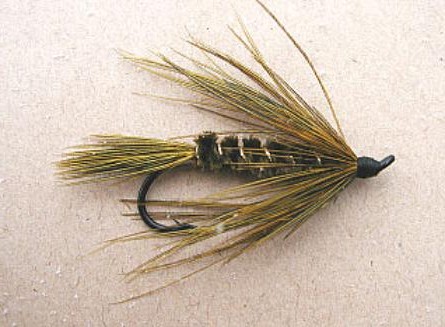
On The Fly
"Fly tying is a school from which we never graduate"
TYING NEWS
The Southern Oregon Fly Tiers met Wednesday, November 8th
at the library in Gold Hill. There was a fly raffle and tying demonstrations
by several talented members. We encourage novice and experienced tiers alike
to drop by for a fun evening. A lot of valuable information will be
exchanged, and there is no fee. Next meeting will be December 13th when we
will continue the popular fly exchange. Join us the second Wednesday of each
month for more fun and the sharing of the art.
RFF will be offering fly tying classes again this year. We
will be adding an advanced class along with the beginner and intermediate
level classes. Classes will begin on Monday January 22nd and run for six
consecutive weeks. There will be no fees and all materials will be provided.
Classes are limited to twelve tiers each; sign up early at the next meeting.
 PATTERN OF THE MONTH - Carey Special (Steelhead Version)
PATTERN OF THE MONTH - Carey Special (Steelhead Version)
Hook: Salmon/Steelhead size #4-10.
Thread: Olive 6/0.
Tail: Olive Pheasant Rump hackle fibers.
Rib: Gold oval tinsel or wire.
Body: Olive chenille.
Hackle: Olive Pheasant Rump hackle feather.
Tying Instructions:
1) Start the thread two eye-lengths behind the eye. This is the thread base
for the body material and the marker for the hackle tie-in point. Wind a
thread base back to just above the point of the hook.
2) Select a generous bunch of pheasant rump hackle barbs about one body
length long for the tail. Tie them in above the hook point and then secure
the butts to the hook shank up to the hook loop return.
3) At the rear of the hook, tie in the gold tinsel for the rib and then the
chenille core.
4) Wind the chenille forward in touching turns and then tie off the chenille.
5) Wind the ribbing forward in five evenly spaced turns and then tie off the
ribbing.
6) Select two rump hackle feathers having barbs long enough to reach past
the end of the hook. Tie in the hackle feathers at the marker for the hackle
tie-in point (Step 1) and wind both feathers forward, sweeping the fibers
rearward while making the turns.
7) Tie back on the hackle to achieve the proper angle. Form a neat head,
whip finish and apply head cement.
The Carey Special was created in the early 1920s by Dr.
Lloyd A. Day and Colonel Carey of British Columbia. Originally named the
Monkey-faced Louise and tied with the hair of a groundhog, it later became
known by its current name in honor of the man who helped design it. Often
called the “original stillwater trout killer,” the Carey Special is still
considered one of the primary patterns for the Kamloops rainbow and the
Klamath Lake trophy trout. Tied in many variations of color and material,
this big, soft hackle wet fly can simulate many insects, including dragonfly
nymphs, caddis nymphs, mayfly nymphs and leeches.
It’s a simple tie using only three materials. The body
material is most often varied and can include peacock herl, chenille,
natural hair and seal-substitute dubbing. Most recently, hook variations
have included steelhead versions in larger sizes. Rusty Randall, owner of
the Silver Sedge Fly Shop in Merlin, Oregon, has been offering a steelhead
version for years and ties it with a red or chartreuse bead head along with
a peacock herl body. “I haven’t met a fish yet that could resist this
pattern” was his comment while showing me his selection. You can add several
wraps of lead wire under the body or any color bead to get the fly down and
in front of the fish. The Carey Special is a great pattern to experiment
with. You have endless choices for the body material and pheasant rump
hackles are available dyed in many great steelhead colors. This one should
be in every fly box, so tie some up, give them a test flight and let me know
how you did.
TYING TIPS
If you are using peacock herl for the body, build up an
underbody with thread or yarn before winding the herl. This will give the
body some bulk and shape while allowing the herl to stay fuzzy. If you use a
rib to strengthen the herl, fine wire counter-wrapped works best. You can
wind the pheasant rump hackle two different ways, by the tip, similar to
partridge, or by the stem. If you tie in at the stem be sure to find the
flexible point and make sure the natural curve of the barbs points to the
rear. It may take more than one feather to achieve a full-looking hackle.
Tie One On,
Dan Kellogg (you can contact me at FLYGUY@EZNORTHWEST.COM)